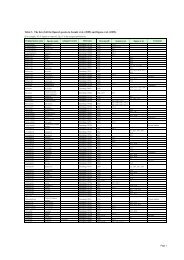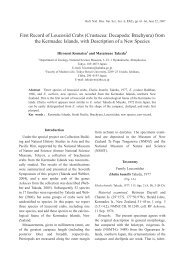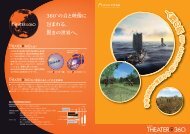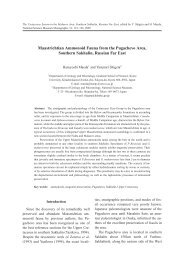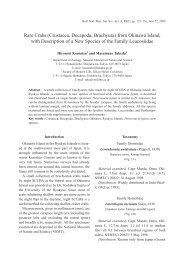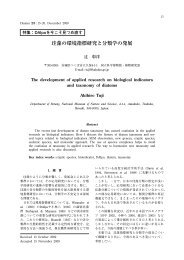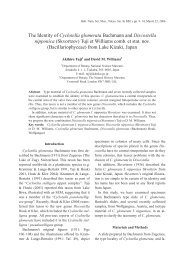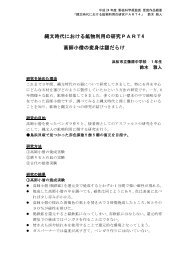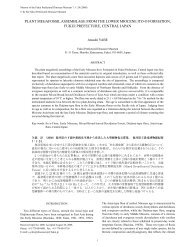Ehrenberg's Radiolarian Collections from Barbados
Ehrenberg's Radiolarian Collections from Barbados
Ehrenberg's Radiolarian Collections from Barbados
You also want an ePaper? Increase the reach of your titles
YUMPU automatically turns print PDFs into web optimized ePapers that Google loves.
JOINT HAECKEL and EHRENBERG PROJECT: Reexamination of the Haeckel and Ehrenberg Microfossil <strong>Collections</strong><br />
as a Historical and Scientific Legacy, edited by Y. Tanimura and Y. Aita, pp. 97–106. National Museum of Nature and<br />
Science Monographs, No. 40, Tokyo 2009<br />
Ehrenberg’s <strong>Radiolarian</strong> <strong>Collections</strong> <strong>from</strong> <strong>Barbados</strong><br />
Kaoru Ogane 1 , Noritoshi Suzuki 1 , Yoshiaki Aita 2 , Toyosaburo Sakai 2<br />
and David Lazarus 3<br />
1 Institute of Geology and Paleontology, Graduate School of Science, Tohoku University,<br />
6–3 Aoba Aramaki, Aoba-ku, Sendai 980–8578, Japan<br />
2 Department of Geology, Faculty of Agriculture, Utsunomiya University,<br />
Utsunomiya 321–8505, Japan<br />
3 Museum für Naturkunde, Humboldt University, Invalidenstrasse 43, 10115 Berlin, Germany<br />
Corresponding Author: Kaoru Ogane (e-mail: ogane@mtc.biglobe.ne.jp)<br />
Abstract <strong>Barbados</strong> radiolarians in the Ehrenberg <strong>Collections</strong> are very important microfossils since<br />
the tropical Middle Eocene to Oligocene radiolarians are largely described by Christian Gottfried<br />
Ehrenberg. As this collections have safely kept in Museum für Naturkunde, Humboldt University,<br />
Berlin, Germany. We reexamined the radiolarians <strong>from</strong> <strong>Barbados</strong> which were originally studied by<br />
Ehrenberg, and of these 250 species were found <strong>from</strong> the collection. All the specimens examined in<br />
our study are illustrated here.<br />
Key words:<br />
<strong>Barbados</strong>, Classification, Ehrenberg, Legacy Collection, Radiolaria, Taxonomy.<br />
Introduction<br />
The “<strong>Barbados</strong> Earth” is long known to comprise remarkably beautiful polycystine radiolarians<br />
since Schomburgk (1847) offered samples <strong>from</strong> <strong>Barbados</strong> to scientists, and these sediments<br />
have been the subject of numerous studies since. Ehrenberg (1846) examined samples <strong>from</strong><br />
Schomburgk, and reported the presence of 282 species although in this paper he did not provide a<br />
species list. Ehrenberg (1847) illustrated 11 species, of which 9 specimens were re-figured on<br />
pages 560 and 561 of Schomburgk (1847). The majority of the species which were named by<br />
Ehrenberg were not formally published until the 1870’s. Ehrenberg (1854) illustrated a few<br />
species <strong>from</strong> <strong>Barbados</strong>, as part of copper plates showing 70 polycystine radiolarian species. <strong>Barbados</strong><br />
samples were examined not only by Ehrenberg but also many other persons. Haeckel did<br />
not examine <strong>Barbados</strong> samples in (1862), although he had received some of Schomburgk’s <strong>Barbados</strong><br />
samples <strong>from</strong> Thomas H. Huxley in reply for a complimentary copy of Haeckel (1862) (p.<br />
73 in Di Gregorio, 2005). P.S. Bury (1862) obtained samples of “<strong>Barbados</strong> chalk deposit” <strong>from</strong><br />
Dr. Davy in July 1846. Microscopic slides were prepared <strong>from</strong> these by C. Johnson in 1860 and<br />
1861, and Bury drew the specimens. This publication consists almost solely of photographic reproductions<br />
of Bury’s original drawings. Since little was known about the species composition of<br />
<strong>Barbados</strong> samples at that time, despite the reported presence of 282 species by Ehrenberg (1846),<br />
Bury (1862) identified few species names. Haeckel (1887) cited her figures to propose new<br />
species (pl. 1, fig. 1 for Lithostrobus acuminatus Haeckel 1887; pl. 3, figs. 4 for Xiphostylus anhinga<br />
Haeckel 1887; pl. 4, fig. 4 for Staurosphaera simonis Haeckel 1887; pl. 5, fig. 2 for Dicty-
98 K. Ogane et al.<br />
ocephalus urceolus Haeckel 1887, pl. 5, fig. 3 for Podocyrtis urceolata Haeckel 1887; pl. 17, fig.<br />
7 for Stichopilium macropterum Haeckel 1887; pl. 19, figs. 4–6 for Tetrahedrina quadricornis<br />
Haeckel 1887; pl. 19, fig. 7 for Cyrtocapsa pila Haeckel 1887; and pl. 20, fig. 2 for Saturnalis trchoides<br />
Haeckel 1887) so that Bury (1862) is still important for taxonomic purposes. Although<br />
Ehrenberg (1846) reported the presence of 282 species <strong>from</strong> <strong>Barbados</strong> samples, only 265 species<br />
were described in Ehrenberg (1874) and 85 species were subsequently illustrated in Ehrenberg<br />
(1876). The remaining approximately 180 species were not illustrated by Ehrenberg. Haeckel examined<br />
<strong>Barbados</strong> samples in (1887). He found and described approximately 200 species <strong>from</strong> his<br />
samples, but more than 80 species were not associated with any illustrations, and subsequent<br />
studies generally ignored these un-illustrated species by Ehrenberg and Haeckel. Bütschli (1882)<br />
studied Haeckel’s <strong>Barbados</strong> samples and described the detailed internal structures of nassellarian<br />
radiolarians. His study contributed to a new higher classification of Nassellaria in the middle<br />
20th century (e.g. Petrushevskaya, 1971). Otherwise, fragmentary studies of polycystine radiolarians<br />
<strong>from</strong> <strong>Barbados</strong> were reported (Carter, 1893, 1895, 1896a, 1896b 1896c, 1896d, 1896e,<br />
1896f; Sutton, 1896a, 1896b, 1896c, 1896d). These numerous papers, however, describe a single<br />
species or genus each by each. Earland (1900) made a list of equivalent names of Ehrenberg’s<br />
and Haeckel’s species <strong>from</strong> <strong>Barbados</strong>. In the 20th century, other than a new genus and new<br />
species described by Deflandre (1964), new species was not described any longer <strong>from</strong> <strong>Barbados</strong><br />
samples. All these studies since the first report of Schomburgk (1847) had a problem owing to<br />
the lack of precies knowledge of stratigraphic distributions and the exact localities. Saunders et<br />
al., (1984) first published a modern multidisciplinary biostratigraphic study of <strong>Barbados</strong> material<br />
<strong>from</strong> the Bath Cliff section, and identified the stratigraphic range as the Middle Eocene to the<br />
Lower Oligocene.<br />
Reexamination of both Ehrenberg’s and Haeckel’s species <strong>from</strong> <strong>Barbados</strong> is expected to help<br />
clarify the polycystine radiolarian diversity <strong>from</strong> the Middle Eocene to the Lower Oligocene in<br />
the equatorial regions, and more generally will help us to correctly identify other Eocene-<br />
Oligocene polycystine radiolarians. The polycystine radiolarian specimens that were examined<br />
by Ehrenberg have kept in the Museum für Naturkunde, Humboldt University, Berlin, Germany,<br />
and the Ehrenberg Collection is well curated (Lazarus and Jahn, 1998; Lazarus, 1998; Lazarus<br />
and Suzuki, 2009, this volume). To find the actual specimens we used the database of this museum<br />
(http://onlinedb.naturkundemuseum-berlin.de/v1/default.asp) and the original source materials,<br />
curated originally by Clara Ehrenberg, the youngest daughter of Christian Gottfried Ehrenberg.<br />
Using these sources, we successfully identified which specimens were found <strong>from</strong> which<br />
samples. Almost all the specimens examined by Ehrenberg, according to the specimen location<br />
ID on his original drawings, were recognized in our project. Our paper illustrates all polycystine<br />
radiolarian specimens that were digitally imaged <strong>from</strong> samples <strong>Barbados</strong> 1 (pl. 1 in our paper),<br />
43 (pls. 1–2), 94 (pls. 3–8), 16 (pls. 9–10), 25 (pls. 11–25), 30 (pls. 26–60), 14 (pl. 61) and 15<br />
(pls. 62–98), following our cross-references (see Suzuki et al., 2009a, this volume). The specific<br />
relationships between the actual specimens and samples is first published in our paper because<br />
Ehrenberg (1846, 1847, 1854, 1874, 1876) and Schomburgk (1847) did not indicate such information.<br />
The faunal assemblage of Ehrenberg’s <strong>Barbados</strong> radiolarians is also useful to decide their<br />
approximate geologic ages.<br />
Methods<br />
An Olympus BAX51 microscope with 10, 20, 40, and special long distance 80x dry objec-
Ehrenberg’s <strong>Radiolarian</strong>s <strong>from</strong> <strong>Barbados</strong> 99<br />
tives were used. Photos were digitally captured with an old digital camera (27762074 pixels) in<br />
the years of 2004 and 2005, Olympus CAMEDIA(R) C5060WZ (20481536 pixels) in 2006,<br />
and Canon PowerShot(R) A640 (25482736 pixels) in 2007. By using Corel Photo-Paint X3 (R)<br />
for Windows, these images were transferred to grayscale images and the image resolution were<br />
adjusted and cut as appropriate file sizes for publication.<br />
Results<br />
Suzuki et al. (2009b) digitally recorded the Neogene polycystine radiolarians in the Ehrenberg<br />
Collection using two selection rules: (1) All polycystine radiolarians encountered in their<br />
examination were captured in complete scans of all mica strips for Davisstraße, Caltanisetta,<br />
Zante and Aegina, and (2) All polycystine radiolarians regardless of published or not were<br />
searched to record as digital images <strong>from</strong> his mica strips of samples <strong>from</strong> the Philippinischer<br />
Ozean and Californischer Stiller Ozean. Differing <strong>from</strong> the first rule, the second rule was concerned<br />
only specimens that are indicated by Ehrenberg. By contrast, the <strong>Barbados</strong> Earth is lithologically<br />
a radiolarian ooze so that uncountable polycystine radiolarians are embedded in mica<br />
strips. Ehrenberg also recorded so many working species names on the mica trays that we concentrated<br />
on finding only the specimens that are recorded on Ehrenberg’s drawings. The arrangement<br />
of plates in our paper follows the arrangement order of mica strips in the collection, <strong>from</strong><br />
K16B01 to K16B05 (K16B01 is the tray ID in the Ehrenberg Collection). Ehrenberg (1876) listed<br />
16 samples as containing polycystine radiolarians. We did not find polycystine radiolarians<br />
<strong>from</strong> <strong>Barbados</strong> 3, 26, 51, 60, 74, 81 and 95.<br />
<strong>Barbados</strong> 1 (K16B01): Plate 1<br />
Only four specimens (pl. 1, figs. 1a–4d) were marked on Ehrenberg’s drawings. Pterocanium<br />
barbadense Ehrenberg 1874 was only found <strong>from</strong> <strong>Barbados</strong> 1.<br />
<strong>Barbados</strong> 43 (K16B01): Plates 1 and 2<br />
Thyrsocyrtis anthophora Ehrenberg 1874 (pl. 1, figs. 7a–7e) is found only <strong>from</strong> <strong>Barbados</strong> 43.<br />
Haliomma entactinia Ehrenberg 1874 (pl. 1, figs. 5a–5d), Eucyrtidium montiparum Ehrenberg<br />
1874 (pl. 1, figs. 6a–6e), Eucyrtidium versipellis Ehrenberg 1874 (pl. 2, figs. 1a–1d) and Anthocyrtis<br />
hispida Ehrenberg 1874 (pl. 2, figs. 8a–8c) are found <strong>from</strong> several <strong>Barbados</strong> samples, but<br />
the published illustration of these species are derived <strong>from</strong> <strong>Barbados</strong> 43.<br />
<strong>Barbados</strong> 94 (K16B02): Plates 3 to 8<br />
We show 47 specimens <strong>from</strong> <strong>Barbados</strong> 94, and confirmed that 22 specimens were published.<br />
The precision of Ehrenberg’s drawing can be evaluated with Lithobotrys ornata Ehrenberg 1874<br />
(pl. 4, figs. 1a–1d), Lophophaena lynx Ehrenberg 1874 (pl. 3, figs. 4a–4e), Lophophaena radians<br />
Ehrenberg 1874 (pl. 3, figs. 3a–3e, 5a–5d), and Stylodictya hastata Ehrenberg 1874 (pl. 5, figs.<br />
1a–1c). These specimens have incomplete shells, and these imperfections are well shown on<br />
Ehrenberg’s drawings. The drawing of Lithomelissa corythium Ehrenberg 1874 (pl. 4, fig. 5b)<br />
showed a lateral line near the base of the cephalis, but this line is erroneously recognized as being<br />
on the surface but not the internal cephalic structure, based on the actual specimen (pl. 4, figs.<br />
5c–5e). Ehrenberg (1876) shows two horizontal spines extending <strong>from</strong> the thorax of Pterocodon<br />
apis Ehrenberg 1874 (pl. 5, fig. 8a). We also recognized them with the actual specimen (pl. 5,<br />
figs. 8b–8d), but were unable to clarify whether they are actually a part of this specimen or not.
100 K. Ogane et al.<br />
The drawing of Cornutella cucullaris Ehrenberg 1874 (pl. 6, fig. 1a) is flipped horizontal in comparison<br />
with the appearance of the actual specimens (pl. 6, figs. 1b–1d) under the modern microscope.<br />
Lychnocanium tetrapodium Ehrenberg 1874 (pl. 7, figs. 9a–9c) is also flipped between the<br />
drawing and the actual specimen. The broken short feet of this specimen appear to be emerging<br />
<strong>from</strong> the back side of the thorax in the drawing (pl. 7, fig. 9a) but emerged <strong>from</strong> the front side of<br />
the thorax in the actual specimen (pl. 7, fig. 9b). We infer <strong>from</strong> this that Ehrenberg drew this<br />
specimen <strong>from</strong> the back side of the mica strip. These two species are located on the same strip,<br />
Strip 160207, but the other specimens on the same strips were drawn as normal illustrations. We<br />
don’t know why a few specimens are flipped but this may have occurred if when Ehrenberg attached<br />
the newly examined loose mica to the strip for storage he inadvertently reversed the sides.<br />
<strong>Barbados</strong> 16 (K16B03): Plates 9 and 10<br />
A total of 14 specimens are shown in plates 9 and 10. We also recognized the actual specimens<br />
of the unpublished drawings (Histiastrum quaternarium Ehrenberg 1874, pl. 9, figs. 4a–4b;<br />
Podocyrtis bicornis Ehrenberg 1874, pl. 9, figs. 8a–8d; and Podocyrtis argus Ehrenberg 1874, pl.<br />
10, figs. 6a–6c). The specimen of Ceratospyris setigera Ehrenberg 1874 (pl. 9, figs. 3a–3c) is<br />
cracked. The specimen of Pod. bicornis (pl. 10, figs. 8a–8d) is flipped horizontally between the<br />
drawing and the actual specimen on the basis of the orientation of the feet.<br />
<strong>Barbados</strong> 25 (K16B03): Plates 11 to 25<br />
We figured 97 specimens <strong>from</strong> <strong>Barbados</strong> 25. Cracks are relatively strongly developed on the<br />
Canada balsam of the mica strips of <strong>Barbados</strong> 25, and they split Haliomma apertum Ehrenberg<br />
1874 (pl. 11, figs. 1a–1c), Stylodictya clavata Ehrenberg 1874 (pl. 14, figs. 4a–4c) and Stylodictya<br />
dimidiata Ehrenberg 1874 (pl. 17, figs. 3a–3b). Only one specimen of Hal. apertum and<br />
Sty. clavata is marked on the Ehrenberg’s drawings, respectively, so that reference specimens are<br />
shown in pl. 11, figs. 2a–2b for Hal. apertum and in pl. 14, figs. 2a–2b for Sty. clavata <strong>from</strong> the<br />
type material. The drawing of Haliomma triactis Ehrenberg 1874 (pl. 11, fig. 3a) differs <strong>from</strong> the<br />
actual specimen (pl. 11, figs. 3b–3c) in having two shorter radial spines, but this is the only specimen<br />
which is identical with this drawing by the location ID on the Ehrenberg’s drawing and his<br />
working names on the mica tray. The directions of the bi-polar spines of Stylosphaera flexuosa<br />
are different between the drawing (pl. 11, fig. 4d) and the actual specimen (pl. 11, figs. 4b–4f).<br />
This species bears similarity to Dorcadospyris-species (Nassellaria) but a morphologically similar<br />
specimen shown in pl. 11, figs. 5a–5f has a macrosphere so that the latter is Spumellaria. We<br />
did not determine whether Sty. flexuosa belongs to Nassellaria or Spumellaria. Ehrenberg tends<br />
not to draw the internal structure of spherical radiolarians. The Ehrenberg drawings of Hal. triactis<br />
(pl. 11, figs. 3a–3c), Stylosphaera coronata Ehrenberg 1874 (pl. 12, figs. 1a–1d), Stylosphaera<br />
sulcata Ehrenberg 1874 (pl. 12, figs. 3a–3d) and Stylosphaera liostylus Ehrenberg 1874 (pl. 12,<br />
figs. 6a–6f) only show an ambiguous grey area for the internal shells and did not show radial<br />
beams between the cortical shell and medually shell, but the actual specimens have such structures.<br />
The drawings of Haliomma helianthus Ehrenberg 1874 (pl. 15, figs. 1a–1e) and Stylodictya<br />
dimidiata Ehrenberg (pl. 17, figs. 1a–2c) are very rough sketches, but the actual specimens were<br />
nonetheless easily identified. The drawing of Eucyrtidium coronata Ehrenberg 1874 (pl. 19, fig.<br />
4a) has a strange flare-like top on the cephalis, which was confirmed on the actual specimen (pl.<br />
19, figs. 4b–4c). A bizarre four-fold opening in the cephalis is drawn for Lithocorythium oxylophos<br />
Ehrenberg 1847 (pl. 20, figs. 7a–7d, 9a–c) and Lithocorythium platylophos Ehrenberg
Ehrenberg’s <strong>Radiolarian</strong>s <strong>from</strong> <strong>Barbados</strong> 101<br />
1854 (pl. 20, figs. 10a–10c). These images are obliquely developed initial structures of the<br />
cephalis <strong>from</strong> a ventral or dorsal view which are magnified by the lens effect of the convex<br />
cephalic wall. A similar four-fold cephalic opening is shown for Lithopera oxystauros Ehrenberg<br />
1874 (pl. 20, fig. 11a), but the lower part of the openings correspond to the cephalic neck on the<br />
basis of the actual specimen (pl 20, figs. 11b–11d).<br />
<strong>Barbados</strong> 30 (K16B04): Plates 26 to 60<br />
A total of 151 specimens are shown in plates 26 to 60. The drawing of Cenosphaera megapora<br />
Ehrenberg 1874 (pl. 26, fig. 1a) shows four cylindrical radial spines and does not show any internal<br />
structure. The actual specimen of this species (pl. 26, figs. 1b–1c) has more than eight, triradiate<br />
radial spines and consists of three concentric shells. The internal structure is often missing<br />
for other specimens of Cen. megapora (pl. 27, figs. 1a–1b, pl. 28, figs. 1a–2b). The original<br />
drawings of Haliomma oculatum Ehrenberg 1874 (pl. 28, fig. 3a) and Haliomma echinatum<br />
Ehrenberg 1874 (pl. 30, figs. 1a–1c) were not informative as to whether this species is spherical<br />
or has a flattened test, but the actual specimen (pl. 28, figs. 3b–3c) has a discoidal cortical shell,<br />
with a pear-shaped internal shell located in the equatorial plane of the test. The internal structure<br />
of Stylodictya carduus Ehrenberg 1874 was ambiguously drawn by Ehrenberg (pl. 29, fig. 1a in<br />
our paper). The actual specimen of this species (pl. 29, figs. 1b–1d) has a thick-walled cortical<br />
shell and double medullary shells. The drawing and actual specimens of Stylosphaera laevis<br />
Ehrenberg 1874 (pl. 29, figs. 3a–3c) are at first confusing. The drawing indicates with grey shading<br />
the presence of some internal structure, but the actual specimen internal structures appear to<br />
be absent. This actual appearance is supported by the other specimen of the representative<br />
species (pl. 29, figs. 4a–4b) but is not supported by ambigous structures inside another specimen<br />
(pl. 29, figs. 6a–6b). This is clarified by the specimen <strong>from</strong> <strong>Barbados</strong> 14 (pl. 61, figs. 2a–2c),<br />
which has a pear-shaped internal shell. Similar problems may arise in other bipolar spherical radiolarians.<br />
The image of Stylosphaera sulcata Ehrenberg 1874 (pl. 29, figs. 5a–5b) does not have<br />
internal structures, but additional specimens should be examined for confirmation of this issue.<br />
Ehrenberg identified the specimen shown in pl. 31, figs. 4a–4b in our paper as Cycladophora discoides<br />
Ehrenberg 1874 on his original drawing, but the concentric peripheral structure and probable<br />
hollow space inside the test are identical with a half shell, split along the equatorial plane, of<br />
Stylodictya dimidiata Ehrenberg 1874 (See, pl. 32, figs. 1a–1c), Lithocyclia ocellus Ehrenberg<br />
1854 (See pl. 32, figs. 2a–2b) or Lithocyclia stella Ehrenberg 1874 (See pl. 32, figs. 4a–4c). The<br />
drawing of Thyrsocyrtis pristis Ehrenberg 1874 (pl. 35, fig. 4a) could not be matched to any polycystine<br />
radiolarian individuals, but the actual specimen (pl. 35, figs. 4b–4d) is easily identifiable<br />
as an approximately one-third fragment of Cladospyris tribrachiata Ehrenberg 1874 (pl. 35, figs.<br />
2a–2c). Ehrenberg (1874) described Cenosphaera spinulosa Ehrenberg 1874 (pl. 38, figs. 3a–4d<br />
in our paper). In the original drawings of this species it is difficult to recognize specific skeletal<br />
characters. The actual specimens look appears to belong to the family Acanthodesmidae. Ceratospyris<br />
longibarba Ehrenberg 1874 (pl. 38, figs. 8a–8d) seems to have an elongated cephalis on<br />
the basis of pl. 38, fig. 8a, but this appearance is simply interpreted as a lateral view because the<br />
D ring is shown in pl. 38, figs. 8b–8c. Lychnocanium falciferum Ehrenberg 1854 (pl. 43, figs<br />
1a–1c) is split by a crack in the Canada balsam. We compared several two chambered nassellarians<br />
bearing three-feet (pls. 41 to 43) to understand the skeletal structure of Lyc. falciferum (e.g.<br />
pl. 43, figs. 2a–2c). The drawing of Halicalyptra galea Ehrenberg 1874 (pl. 44, fig. 2a) is a rough<br />
sketch with no clearly marked segmentation. The actual specimen (pl. 44, figs. 2b–2g) shows two<br />
segments. Pterocanium contiguum Ehrenberg 1874 (pl. 47, figs. 8a–8d) is difficult to observe in
102 K. Ogane et al.<br />
detail owing to the roughness of the embedded Canada balsam. Alternate specimens should be<br />
chosen when a lectotype or neotype is designated.<br />
Eucyrtidium argus Ehrenberg 1874 (pl. 48, figs. 8a–8f) has a constriction between the cephalo-thorax<br />
part and thorax, differing <strong>from</strong> the original drawing. This species also has a cylindrical<br />
opening on the basal part of the apical horn (pl. 48, fig. 8d). This opening seems to be connected<br />
with the A rod of the cephalic internal structure (pl. 48, figs. 8e–if). The relationship between a<br />
basal opening on the apical horn and an A rod is recognized in many species. Podocyrtis princeps<br />
Ehrenberg 1874 (pl. 54, figs. 1a–1f) has a short opening which starts <strong>from</strong> the tip of the A<br />
rod (pl. 54, fig. 1f) and vents at the left side of the proximal apical horn, 50 mm above the boundary<br />
of cephalis and apical horn (the concave part on the apical horn in pl. 54, fig. 1e). The specimen<br />
of pl. 59, figs. 1a–1c in our paper has also a typical opening inside the apical horn.<br />
Differing <strong>from</strong> the species having a penetration, Eucyrtidium alauda Ehrenberg 1874 (pl. 49,<br />
figs. 1a–1e), Eucyrtidium scolopax Ehrenberg (pl. 58, figs. 3a–3f), Podocyrtis attenuata Ehrenberg<br />
1874 (pl. 56, figs. 2a–3d), Podocyrtis bicornis Ehrenberg 1874 (pl. 55, figs. 2a–2e) and<br />
Podocyrtis papalis Ehrenberg 1847 (pl. 58, figs. 1a–1f) have a branched basal portion of the apical<br />
horn. One of branches is always connected with the A rod of the cephalic internal structure.<br />
In the case of Anthocyrtis serrulata Ehrenberg 1874 (pl. 51, figs. 1a–1f), a triradiate short apical<br />
horn is encased within the thickened siliceous wall above the cephalis (pl. 51, fig. 1d).<br />
Ehrenberg (1876) showed a very long apical horn for Podocyrtis princeps Ehrenberg 1874<br />
(pl. 54, fig. 1a in our paper) and Podocyrtis cothurnata Ehrenberg 1874 (pl. 55, fig. 1a), which is<br />
confirmed by the actual specimen (pl. 54, figs. 1b–1f). Another specimen of Pod. princeps (pl.<br />
54, figs. 2a–2c) also possesses a very long apical horn.<br />
<strong>Barbados</strong> 14 (K16B05): Plate 61<br />
Six specimens are shown in pl. 61 of our paper. The published drawings of Lithobotrys<br />
adspera (pl. 61, figs. 5a–5d) and Lithochytris pyramidalis Ehrenberg 1874 (pl. 61, figs. 6a–6c)<br />
were found <strong>from</strong> <strong>Barbados</strong> 14.<br />
<strong>Barbados</strong> 15 (K16B05): Plates 62 to 98<br />
A total of 172 specimens were illustrated <strong>from</strong> pl. 62 to pl. 98. As for <strong>Barbados</strong> 15, many<br />
specimens were drawn by Ehrenberg.<br />
The drawing of Cenosphaera micropora Ehrenberg 1874 (pl. 61, fig. 1a) did not show any internal<br />
structure, but the actual specimen (pl. 61, figs. 1b–1e) has one medullary shell at least. Although<br />
we searched better preserved specimens of this species in the type mica slides <strong>from</strong> <strong>Barbados</strong><br />
15, specimens adequate to examine the internal structure were not found. Stylosphaera<br />
liostylus Ehrenberg 1874 (pl. 63, figs. 1a–1e) was drawn with two long bipolar spines, but the actual<br />
specimen doesn’t have so long bipolar spines. The detailed structure of the internal shell cannot<br />
be documented precisely due to poor optical quality. The drawing of Stylodictya setigera<br />
Ehrenberg 1874 (pl. 63, fig. 4c) was not detailed enough to determine whether this species has a<br />
spherical or flattened shape. The actual specimen of this species (pl. 63, figs. 4a–4b, 4d–4e) can<br />
be precisely focused on the nearly whole area of the upper surface at once so that it has a somewhat<br />
flattened spherical test. The drawing shows double spiral structure, but the details of three<br />
dimensional structure were not determined because we did not examine other specimens of this<br />
species. Similarly, the drawing of Stylodictya echinastrum (pl. 64, fig. 1a) can be interpreted as<br />
either a spherical or flattened shape. In our examination this species has a spherical form (pl. 64,<br />
figs. 1b–1c). This is supported by the other specimens identified as this species by Ehrenberg (see
Ehrenberg’s <strong>Radiolarian</strong>s <strong>from</strong> <strong>Barbados</strong> 103<br />
pl. 64, figs. 2a–3b).<br />
Stylodictya gracilis Ehrenberg 1854 (pl. 65, figs. 1a–1c) is the type species of the genus Stylodictya.<br />
The detailed morphological description and taxonomic reexamination of this species<br />
using this specimen was published in Ogane et al. (2009). As Suzuki et al. (2009a, this volume)<br />
point out in the inclination of his drawing, the outline of a specimen tends to become narrowed.<br />
This inclination has a strong effect on the drawing of Stylodictya perichlamydium Ehrenberg<br />
1874 (pl. 65, figs. 2a–2e). The drawing of this species shown in our pl. 65, fig. 2a was rotated at<br />
an angle of 90 degrees to be fixed with the orientation of the actual specimen shown in pl. 65,<br />
figs. 2a–2b and 2d–2e. The actual specimen of this species is more elliptical than indicated in the<br />
drawing. The location of Stylodictya ocellata Ehrenberg 1874 is recorded at “15.1.b.w”, relevant<br />
to Strip 160505.b.w on the Ehrenberg’s drawing and is also written at this location on the mica<br />
tray. However, this specimen was found <strong>from</strong> a different location (Strip 160508 r et bl, meaning<br />
between paper rings “r” and “bl”, following Ehrenberg’s indication rule). This specimen (pl. 65,<br />
figs. 3a–3f) is partly broken off, and the preservation is relatively poor. An alternative specimen<br />
for designating a neotype should be found <strong>from</strong> the topotype material of <strong>Barbados</strong> 15. Astromma<br />
pentactis Ehrenberg 1874 (pl. 69, figs. 1a–1c) and Histiastrum quaternarium Ehrenberg 1874 (pl.<br />
69, figs. 2a–2c) were found <strong>from</strong> <strong>Barbados</strong> 15, but were poorly preserved. The specimen of His.<br />
quaternarium illustrated in pl. 69, figs. 2a–2c was subsequently designated as the lectotype of<br />
this species by Ogane et al. (2009) because this is the type species of the genus Histiastrum. One<br />
arm of Astromma pythagorae Ehrenberg 1854 was drawn with a lighter grey color (pl. 70, fig.<br />
3a). The light colored part is a partially lost portion of the arm in the actual specimen (pl. 70,<br />
figs. 3b–3c). The drawing of Dictyospyris spinulosa Ehrenberg 1874 (pl. 76, fig. 5a) have short<br />
spinules around the test, but the actual specimen (pl. 76, figs. 5b–5e) has more robust, longer<br />
spines. The drawing of Ceratospyris triomma (pl. 78, fig. 2a) does not seem to correspond to the<br />
actual specimen (pl. 78, figs. 2b–2d). However, only one specimen identified as this species on<br />
the mica labels was found <strong>from</strong> the exact location. Pterocodon campanella Ehrenberg 1874 was<br />
drawn to have two lateral spines <strong>from</strong> the upper part of the thorax (pl. 80, fig. 3a), but we did not<br />
confirm the presence of two lateral spines in the actual specimen (pl. 80, figs. 3b–3c). The drawing<br />
of Cornutella cucullaris Ehrenberg 1874 (pl. 81, fig. 3a) is horizontally flipped in comparison<br />
with the appearance of the actual specimen (pl. 81, figs. 3b–3g), and furthermore, this specimen<br />
was drawn as being much narrower than the actual specimen. The drawing of Cornutella mitra<br />
Ehrenberg 1874 (pl. 82, fig. 3a) was not clear on the presence of cephalis. The actual specimen of<br />
this species (pl. 82, figs. 3b–3d) consists of very small cephalis and large thorax. The published<br />
image of Eucyrtidium barbadense Ehrenberg 1874 (pl. 9, fig. 7 in the original paper pl. 85, fig.<br />
7a in our paper) appears to be a well preserved specimen to understand the morphological characters.<br />
By contrast, the optical image of the actual specimen (pl. 85, figs. 7b–7c) is extremely<br />
poor due to the rough surface of the Canada balsam.<br />
The actual specimens of Podocyrtis nana Ehrenberg 1874 (pl. 89, figs. 2a–2c), Eucyrtidium<br />
sphaerophilum Ehrenberg 1874 (pl. 89, figs. 1a–1c), Podocyrtis brevipes Ehrenberg 1874 (pl. 89,<br />
figs. 3a–3c) appear to have rough surface texture, probably owing to the rough surface of the<br />
Canada balsam, although the drawings of these specimens show their characteristic morphology<br />
very well. These specimens are nearly completely preserved individuals, but a neotype should<br />
probably be selected for these species. The actual specimen of Podocyrtis ventricosa Ehrenberg<br />
1874 (pl. 92, figs. 4a–4b) is identical to the drawing, but we were unable to take photographs the<br />
upper portion of the specimen because the focal depth is insufficient to image this part of the<br />
specimen, even if we used 10X objective lens. This specimen should be also replaced with other
104 K. Ogane et al.<br />
specimen when the type specimen is selected for defining the species.<br />
The drawing of Podocyrtis pentacantha Ehrenberg 1874 (pl. 93, fig. 1a in our paper) shows<br />
the both sides of the specimen, indicating that Ehrenberg examined some specimens <strong>from</strong> the<br />
both sides of the mica strip because two images of the same specimen in his drawing are flipped<br />
horizontally. Dictyopodium eurylophos Ehrenberg 1874 is also flipped horizontally between the<br />
drawing (pl. 93, fig. 3a) and the actual specimen (pl. 93, figs. 3b–3f), indicating that this specimen<br />
was observed by Ehrenberg <strong>from</strong> the backside of the mica stip because the base of the single<br />
foot arises <strong>from</strong> the other side of the abdomen.<br />
The drawing of Lithomelissa ventricosa Ehrenberg 1874 (pl. 96, fig. 1a) shows very short<br />
feet extending <strong>from</strong> the lower portion of the final segment, but we did not recognize these feet in<br />
the actual specimen (pl. 96, figs. 1b–1d): Instead, a weak constriction is recognized on the upper<br />
portion of the “final segment” in the sense of Ehrenberg’s drawing, and this species may actually<br />
have three segmentations. The lack of feet and presence of the weak constriction is confirmed by<br />
the other specimen of the species (pl. 96, figs. 2a–2d).<br />
Concluding remarks<br />
Ehrenberg generally recorded the location ID of his examined specimens on his drawings,<br />
but we did not choose the specimens illustrated here solely by relying on his drawing ID or location<br />
reference <strong>from</strong> published sources. We successfully located almost all the actual specimens<br />
by these procedures. Many details of the skeletal morphological characters of spheroidal spumellarians<br />
(pl. 11, figs. 1a–3c, pls. 12, 26, 27, 28, 29, 64), discoidal spumellarians (pl. 5, figs. 1a–1c,<br />
pls. 14–17, 30, 65, 66, 69) and the larger cephalis-bearing and small nassellarians (pl. 3, figs.<br />
3a–5d, pls. 4, 19, 20, pl. 34, figs. 2a–3c, pl. 62, 79,) <strong>from</strong> <strong>Barbados</strong> have not been recognizable<br />
<strong>from</strong> Ehrenberg’s drawings. These characters are for the most part easily recognizable on the actual<br />
specimens. Although several species will probably be synonymized with well-known<br />
species, rules on the priority of species names under the ICZN will raise issues of taxonomic stability<br />
which must be taken into account.<br />
The actual specimens of potential lectotypes were identified by comparison to the drawings,<br />
but some of the specimens so identified are unsuitable to use as lectotypes due to the state of<br />
preservation. Ceratospyris setigera (pl. 9, figs. 3a–3c), Haliomma apertum (pl. 11, figs. 1a–1c),<br />
Stylodictya clavata (pl. 14, figs. 4a–4c), Podocyrtis cothurnata (pl. 55, figs. 1a–1e), Podocyrtis<br />
schomburgkii (pl. 57, figs. 1a–1f) and Haliomma triactis (pl. 67, figs. 2a–2d) are cracked in the<br />
Canada balsam so that the type designation of these specimens would be problematic due to<br />
preparation aging. Other specimens are partly broken or ambiguous for other reasons, but not due<br />
to problems with their mica’s preservation.<br />
Acknowledgement<br />
We thank Mr. Kentaro Chiba for his assisting our research in Museum für Naturkunde, Humboldt<br />
University.<br />
References<br />
Bury, P. S., 1862. Polycystins, Figures of Remarkable Forms & c., in the <strong>Barbados</strong> Chalk Deposit, (Chiefly Collected by<br />
Dr. Davy, and Notice in a Lecture to the Agricultural Society of <strong>Barbados</strong>, in July, 1846), W. Weldon, London, 25
Ehrenberg’s <strong>Radiolarian</strong>s <strong>from</strong> <strong>Barbados</strong> 105<br />
plates.<br />
Bütschli, O., 1882. Beiträge zur Kenntnis des Radiolarienskelette, insbesondere der der Cyrtida. Zeit. Wissen. Zool., 36:<br />
485–540.<br />
Carter, F. B., 1893. Classification of the Radiolaria: Key to the species of <strong>Barbados</strong> (Continued <strong>from</strong> p. 85, March, 1895).<br />
Am. Monthly Microscop. Jour., 14: 206–213.<br />
Carter, F. B., 1895. Classification of the Radiolaria: Key to the species of <strong>Barbados</strong>. Am. Monthly Microscop. Jour., 16:<br />
81–85.<br />
Carter, F. B., 1896a. Classification of the Radiolaria: Key to the species of <strong>Barbados</strong> (Continued <strong>from</strong> p. 213, July, 1895,<br />
and concluded). Am. Monthly Microscop. Jour., 17(1): 19–25.<br />
Carter, F. B., 1896b. Radiolaria: A new species <strong>from</strong> <strong>Barbados</strong>. Am. Monthly Microscop. Jour., 17(1): 25–26.<br />
Carter, F. B., 1896c. Radiolaria: A new species <strong>from</strong> <strong>Barbados</strong>. Am. Monthly Microscop. Jour., 17(2): 57–58.<br />
Carter, F. B., 1896d. Radiolaria <strong>from</strong> <strong>Barbados</strong>: A correction. Am. Monthly Microscop. Jour., 17(2): 62.<br />
Carter, F. B., 1896e. Radiolaria: A new genus <strong>from</strong> <strong>Barbados</strong>. Am. Monthly Microscop. Jour., 17(3): 96–97.<br />
Carter, F. B., 1896f. Radiolaria, a new species. Am. Monthly Microscop. Jour., 18(7): 241–242.<br />
Deflandre, G., 1964. Sur le sens de développement centrifuge ou centrepète des éléments de la coque Radiolaires<br />
Sphaerellaires. Compt. Rend. Heb. Séan. Acad. Sci., 259: 2117–2119.<br />
Di Gregorio, M. A., 2005. From Here to Eternity. Ernst Haeckel and Scientific Faith, Vandenhoeck & Ruprecht, 637 pp.<br />
Earland, A., 1900. A list of the fossil Radiolaria <strong>from</strong> <strong>Barbados</strong>, figured in Ehrenberg’s “Fortsetzung der mikrogeologischen<br />
Studien”, with equivalent names used by Haeckel. Jour. Quekett Microscop. Club, Ser 2, 7(46): 285–294.<br />
Ehrenberg, C. G., 1846. Über eine halibiolithische, von Herrn R. Schomburgk entdeckte, vorherrschend aus mikroskopischen<br />
Polycystinen gebildete, Gebirgsmasse von <strong>Barbados</strong>. Ber. Königl. Preuß. Akad. Wiss. Berlin, 1846: 382–385.<br />
Ehrenberg, C. G., 1847. Über die mikroskopischen kieselschaligen Polycystinen als mächtige Gebirgsmasse von <strong>Barbados</strong><br />
und über das Verhältniss der aus mehr als 300 neuen Arten bestehenden ganz eigenthümlichen Formengruppe<br />
jener Felsmasse zu den jetzt lebenden Thieren und zur Kreidebildung. Eine neue Anregung zur Erforschung des<br />
Erdlebens. Ber. Königl. Preuß. Akad. Wiss. Berlin, 1847: 40–60.<br />
Ehrenberg, C. G., 1854. Mikrogeologie. Voss, Leipzig, 374 pp.<br />
Ehrenberg, C.G., 1874. Grössere Felsproben des Polycystinen-Mergels von <strong>Barbados</strong> mit weiteren Erläuterungen. Monat.<br />
Königl. Akad. Wiss. Berlin, 1873: 213–262.<br />
Ehrenberg, C. G., 1876. Fortsetzung der mikrogeologischen Studien als Gesammt-Übersicht der mikroskopischen<br />
Paläontologie gleichartig analysirter Gebirgsarten der Erde, mit specieller Rücksicht auf den Polycystinen-Mergel<br />
von <strong>Barbados</strong>. Abh. Königl. Akad. Wiss. Berlin, 1875: 1–225.<br />
Haeckel, E., 1862. Die Radiolarien (Rhizopoda Radiolaria). Eine Monographie. Tafel 1, Reimer, Berlin, 572 pp.<br />
Haeckel, E., 1887. Report on the Radiolaria collected by H.M.S. Challenger during the years 1873–1876. Rep. Sci. Res.<br />
Voyage H.M.S. Challenger 1873–1876, Zool., 18: 1–1803.<br />
Lazarus, D., 1998. The Ehrenberg Collection and its curation. In D. M. Williams & R. Huxley (eds.) Christian Gottfried<br />
Ehrenberg (1795–1876), The Man and His Legacy, Special Publication of the Linnean Society, Academic Press, p.<br />
14–29.<br />
Lazarus, D. & R. Jahn, 1998. Using the Ehrenberg collection. Diatom Res., 13: 273–291.<br />
Lazarus, D. & N. Suzuki, 2009. Introduction to the reexamination of the Haeckel and Ehrenberg radiolarian collections.<br />
In Y. Tanimura & Y. Aita (eds.), Joint Haeckel and Ehrenberg Project, Reexamination of the Haeckel and Ehrenberg<br />
Microfossil <strong>Collections</strong> as a Historical and Scientific Legacy, National Museum of Nature and Science<br />
Monographs, 40: 23–34.<br />
Ogane, K., N. Suzuki, Y. Aita, D. Lazarus & T. Sakai, 2009, The Ehrenberg type species of flat-shaped radiolarian genera<br />
(Spongodiscidae and Stylodictyidae, Spumellaria, Polycystina). Jour. Syst. Palaeont., 7: 81–94.<br />
Petrushevskaya, M. G., 1971. Radiolyarii Nasselaria v planktone Mirovogo okeana. Trud. Zool. Inst., Akad. Nauk, SSSR,<br />
9(17): 1–294.<br />
Saunders, J. B., D. Bernoulli, E. Müller-Merz, H. Oberhänsli, K. Perch-Nielsen, W. Riedel, R. A. Sanfilippo & R. J.<br />
Torrini, 1984. Stratigraphy of the late Middle Eocene to Early Oligocene in the Bath Cliff section, <strong>Barbados</strong>, West<br />
Indies. Micropaleontology, 30: 390–425.<br />
Schomburgk, R. H., 1847. The History of <strong>Barbados</strong>. Cass Library of West Indian Studies, no. 19 (reprinted version printed<br />
in 2001), Frank Cass, 722 pp.<br />
Sutton, H. J., 1896a. Radiolaria; a new species <strong>from</strong> <strong>Barbados</strong>. Am. Monthly Microscop. Jour., 17(2): 58–60.<br />
Sutton, H. J., 1896b. Radiolaria; a new genus <strong>from</strong> <strong>Barbados</strong>. Am. Monthly Microscop. Jour., 17(2): 61–62.<br />
Sutton, H. J., 1896c. Radiolaria; a new genus <strong>from</strong> <strong>Barbados</strong>. Am. Monthly Microscop. Jour., 17(4): 138–139.
106 K. Ogane et al.<br />
Sutton, H. J., 1896d. Radiolaria; two new species <strong>from</strong> <strong>Barbados</strong>. Am. Monthly Microscop. Jour., 17(5): 161–163.<br />
Suzuki, N., 2009. <strong>Radiolarian</strong> studies by Christian Gottfried Ehrenberg (1795–1876) and value of his species as type<br />
species of genera. In Y. Tanimura & Y. Aita (eds.), Joint Haeckel and Ehrenberg Project, Reexamination of the<br />
Haeckel and Ehrenberg Microfossil <strong>Collections</strong> as a Historical and Scientific Legacy, National Museum of Nature<br />
and Science Monographs, 40: 55–69.<br />
Suzuki, N., D. Lazarus, K. Ogane, Y. Aita & T. Sakai, 2009a, General results of reexamination of Ehrenberg’s radiolarian<br />
collections: with instructions on efficient methods to find microfossils <strong>from</strong> the Collection. In Y. Tanimura & Y.<br />
Aita (eds.), Joint Haeckel and Ehrenberg Project, Reexamination of the Haeckel and Ehrenberg Microfossil <strong>Collections</strong><br />
as a Historical and Scientific Legacy, National Museum of Nature and Science Monographs, 40: 71–86.<br />
Suzuki, N., K. Ogane, Y. Aita, T. Sakai & D. Lazarus, 2009b. Reexamination of Ehrenberg’s Neogene radiolarian collections<br />
and its impact on taxonomic stability. In Y. Tanimura & Y. Aita (eds.), Joint Haeckel and Ehrenberg Project,<br />
Reexamination of the Haeckel and Ehrenberg Microfossil <strong>Collections</strong> as a Historical and Scientific Legacy, National<br />
Museum of Nature and Science Monographs, 40: 87–96.<br />
(Note: All the plates and other tables are prepared as the attachments in the CD at the back of the monograph.)



